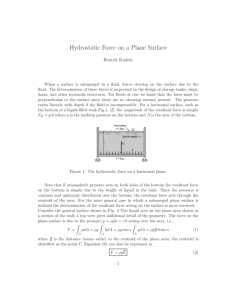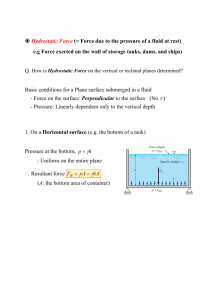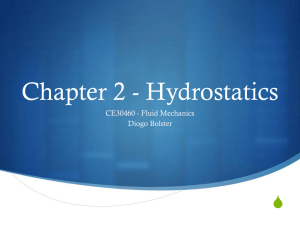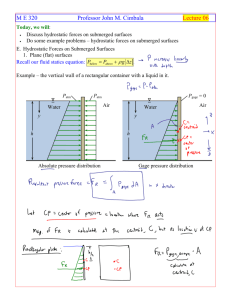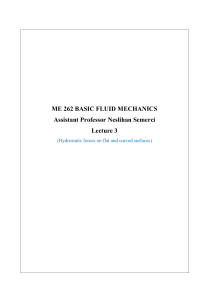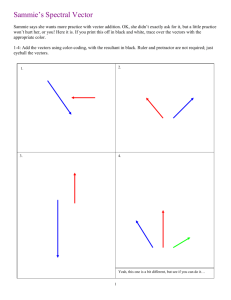MAE 3130: Fluid Mechanics Lecture 2: Fluid Statics (Part B) Spring
advertisement
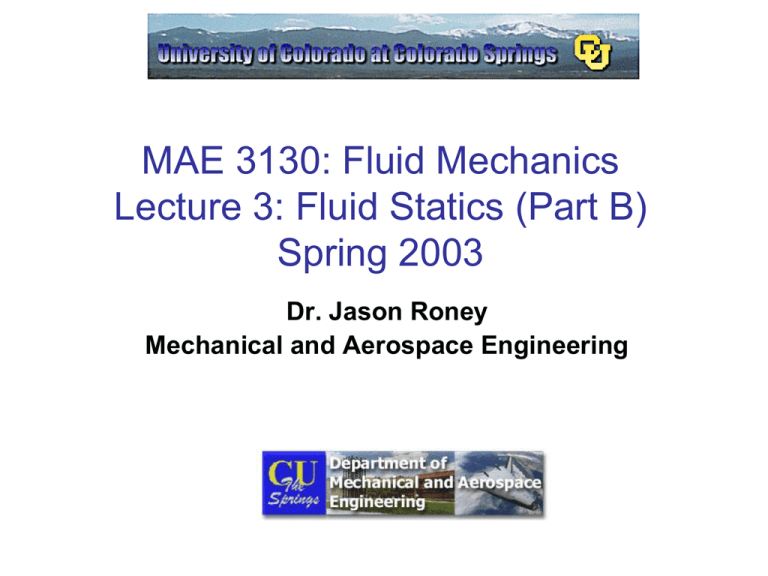
MAE 3130: Fluid Mechanics Lecture 3: Fluid Statics (Part B) Spring 2003 Dr. Jason Roney Mechanical and Aerospace Engineering Outline • • • • • • Hydrostatic Force on a Plane Surface Pressure Prism Hydrostatic Force on a Curved Surface Buoyancy, Flotation, and Stability Rigid Body Motion of a Fluid Example Problems Hydrostatic Force on a Plane Surface: Tank Bottom Simplest Case: Tank bottom with a uniform pressure distribution p - h = patm - patm p h Now, the resultant Force: FR = p A Acts through the Centroid A = area of the Tank Bottom Hydrostatic Force on a Plane Surface: General Case The origin O is at the Free Surface. q is the angle the plane makes with the free surface. y is directed along the plane surface. A is the area of the surface. dA is a differential element of the surface. dF is the force acting on the differential element. C is the centroid. CP is the center of Pressure FR is the resultant force acting through CP General Shape: Planar View, in the x-y plane Hydrostatic Force on a Plane Surface: General Case Then the force acting on the differential element: Then the resultant force acting on the entire surface: We note h = ysinq With and q taken as constant: We note, the integral part is the first moment of area about the x-axis Where yc is the y coordinate to the centroid of the object. hc Hydrostatic Force on a Plane Surface: Location Now, we must find the location of the center of Pressure where the Resultant Force Acts: “The Moments of the Resultant Force must Equal the Moment of the Distributed Pressure Force” Moments about the x-axis: And, note h = ysinq We note, Second moment of Intertia, Ix Then, Parallel Axis Thereom: Ixc is the second moment of inertia through the centroid Substituting the parallel Axis thereom, and rearranging: We, note that for a submerged plane, the resultant force always acts below the centroid of the plane. Hydrostatic Force on a Plane Surface: Location Moments about the y-axis: FR xR xdF A And, note h = ysinq We note, Second moment of Intertia, Ixy Then, Parallel Axis Thereom: I xy I xyc Axc yc Ixc is the second moment of inertia through the centroid Substituting the parallel Axis thereom, and rearranging: Hydrostatic Force on a Plane Surface: Geometric Properties Centroid Coordinates Areas Moments of Inertia Hydrostatic Force: Vertical Wall Find the Pressure on a Vertical Wall using Hydrostatic Force Method Pressure varies linearly with depth by the hydrostatic equation: The magnitude of pressure at the bottom is p = h O The depth of the fluid is “h” into the board The width of the wall is “b” into the board yR = 2/3h By inspection, the average pressure occurs at h/2, pav = h/2 The resultant force act through the center of pressure, CP: y-coordinate: 1 I xc bh 3 12 h 2 A bh yc bh 3 h yR h 12 bh 2 2 h h 2 yR h 6 2 3 Hydrostatic Force: Vertical Wall x-coordinate: I xyc 0 b yc 2 A bh xR 0 h bh 2 b xR 2 b 2 Center of Pressure: b 2h , 2 3 Now, we have both the resultant force and its location. The pressure prism is a second way of analyzing the forces on a vertical wall. Pressure Prism: Vertical Wall Pressure Prism: A graphical interpretation of the forces due to a fluid acting on a plane area. The “volume” of fluid acting on the wall is the pressure prism and equals the resultant force acting on the wall. Resultant Force: O Volume FR 1 h bh 2 FR 1 h A 2 Location of the Resultant Force, CP: The location is at the centroid of the volume of the pressure prism. Center of Pressure: b 2h , 2 3 Pressure Prism: Submerged Vertical Wall Trapezoidal The Resultant Force: break into two “volumes” F1 h1 A 1 F2 h2 h1 A 2 A bh2 h1 Location of Resultant Force: “use sum of moments” Solve for yA y1 and y2 is the centroid location for the two volumes where F1 and F2 are the resultant forces of the volumes. Pressure Prism: Inclined Submerged Wall Now we have an incline trapezoidal volume. The methodology is the same as the last problem, and we affix the coordinate system to the plane. The use of pressure prisms in only convenient if we have regular geometry, otherwise integration is needed In that case we use the more revert to the general theory. Atmospheric Pressure on a Vertical Wall Gage Pressure Analysis Absolute Pressure Analysis But, So, in this case the resultant force is the same as the gag pressure analysis. It is not the case, if the container is closed with a vapor pressure above it. If the plane is submerged, there are multiple possibilities. Hydrostatic Force on a Curved Surface • General theory of plane surfaces does not apply to curved surfaces • Many surfaces in dams, pumps, pipes or tanks are curved • No simple formulas by integration similar to those for plane surfaces • A new method must be used Then we mark a F.B.D. for the volume: Isolated Volume Bounded by AB an AC and BC F1 and F2 is the hydrostatic force on each planar face FH and FV is the component of the resultant force on the curved surface. W is the weight of the fluid volume. Hydrostatic Force on a Curved Surface Now, balancing the forces for the Equilibrium condition: Horizontal Force: Vertical Force: Resultant Force: The location of the Resultant Force is through O by sum of Moments: Y-axis: F1 x1 Wxc FV xV X-axis: F2 x2 FH xH Soda Pop Bottle Curved Surface: Buoyancy: Archimedes’ Principle Archimedes’ Principle states that the buoyant force has a magnitude equal to the weight of the fluid displaced by the body and is directed vertically upward. Archimedes (287-212 BC) Story •Buoyant force is a force that results from a floating or submerged body in a fluid. •The force results from different pressures on the top and bottom of the object •The pressure forces acting from below are greater than those on top Now, treat an arbitrary submerged object as a planar surface: Forces on the Fluid Arbitrary Shape V Buoyancy and Flotation: Archimedes’ Principle Balancing the Forces of the F.B.D. in the vertical Direction: W h2 h1 A V Then, substituting: W is the weight of the shaded area F1 and F2 are the forces on the plane surfaces FB is the bouyant force the body exerts on the fluid Simplifying, Cartesian Diver: The force of the fluid on the body is opposite, or vertically upward and is known as the Buoyant Force. The force is equal to the weight of the fluid it displaces. Buoyancy and Flotation: Archimedes’ Principle Find where the Buoyant Force Acts by Summing Moments: Sum the Moments about the z-axis: VT is the total volume of the parallelpiped We find that the buoyant forces acts through the centroid of the displaced volume. The location is known as the center of buoyancy. Buoyancy and Flotation: Archimedes’ Principle We can apply the same principles to floating objects: If the fluid acting on the upper surfaces has very small specific weight (air), the centroid is simply that of the displaced volume, and the buoyant force is as before. If the specific weight varies in the fluid the buoyant force does not pass through the centroid of the displaced volume, but through the center of gravity of the displaced volume. Step Stratification: Stability: Submerged Object Stable Equilibrium: if when displaced returns to equilibrium position. Unstable Equilibrium: if when displaced it returns to a new equilibrium position. Stable Equilibrium: Unstable Equilibrium: C > CG, “Higher” C < CG, “Lower” Buoyancy and Stability: Floating Object Slightly more complicated as the location of the center buoyancy can change: Barge: Pressure Variation, Rigid Body Motion: Linear Motion Governing Equation with no Shear (Rigid Body Motion): The equation in all three directions are the following: Consider, the case of an open container of liquid with a constant acceleration: Estimating the pressure between two closely spaced points apart some dy, dz: Substituting the partials Along a line of constant pressure, dp = 0: Inclined free surface for ay≠ 0 Pressure Variation, Rigid Body Motion: Linear Motion Now consider the case where ay = 0, and az ≠ 0: Recall, already: Then, So, p 0 x p 0 y p g az z Non-Hydrostatic Pressure will vary linearly with depth, but variation is the combination of gravity and externally developed acceleration. A tank of water moving upward in an elevator will have slightly greater pressure at the bottom. If a liquid is in free-fall az = -g, and all pressure gradients are zero—surface tension is all that keeps the blob together. Pressure Variation, Rigid Body Motion: Rotation Governing Equation with no Shear (Rigid Body Motion): Motion in a Rotating Tank: Write terms in cylindrical coordinates for convenience: Pressure Gradient: Accceleration Vector: Pressure Variation, Rigid Body Motion: Rotation The equation in all three directions are the following: Estimating the pressure between two closely spaced points apart some dr, dz: Substituting the partials Along a line of constant pressure, dp = 0: Equation of constant pressure surfaces: The surfaces of constant pressure are parabolic Pressure Variation, Rigid Body Motion: Rotation Now, integrate to obtain the Pressure Variation: Pressure varies hydrostaticly in the vertical, and increases radialy Some Example Problems
